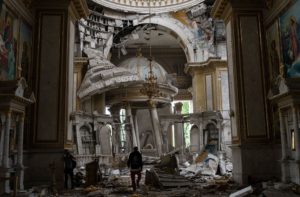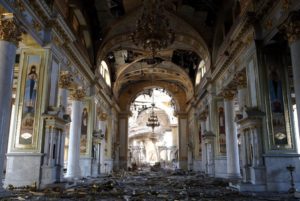The Cathedral of Odesa after Russia’s missile strike (PBS News Hour)
UKRAINE: The Orthodox Cathedral of Odesa destroyed by Putin’s missile strike: calls for funding its restoration (I)
Italy and Greece are first in the line to provide assistance. See pictures of the damage HERE and CNN video
This article was originally published by Bitter Winter on 31 August under the title “Odesa Transfiguration Cathedral 1. After the Russian Bombing, Help is Needed”
By Dr Ievgeniia Gidulianova with Willy Fautré
Bitter Winter (31.08.2023) – On the night of 23 July 2023, the Russian Federation launched a massive missile attack on the center of Odesa which created quite dramatic damages to the Orthodox Transfiguration Cathedral. International support for the reconstruction has quickly been pledged. Italy and Greece are first on the line but much more assistance is needed.
The legal status of the Transfiguration Cathedral is rather complex and unclear. Until May 2022, it was considered a church with a special status and rights of broad autonomy, affiliated to the Ukrainian Orthodox Church/ Moscow Patriarchate (UOC/MP).
On 27 May 2022, the Council of the UOC/ MP removed all references to such dependence from its statutes, stressing its financial autonomy and the absence of any external interference in the appointment of its clergy. It hereby dissociated itself from the Russian Orthodox Church and stopped commemorating Kirill at the divine services because of his support for Vladimir Putin’s war against Ukraine. This distancing did however not lead to a schism from Moscow so that the UOC can keep its canonical status. In the meantime, the process of transfer of UOC parishes to the national Orthodox Church of Ukraine (OCU), founded in December 2018 under President Poroshenko and recognized by Constantinople Patriarchate on 5 January 2019, has accelerated.
In this context, the comment of Archdeacon Andriy Palchuk, a cleric of the Odessa Eparchy of the Ukrainian Orthodox Church (UOC) about the damage caused to the cathedral is worth mentioning: “The destruction is colossal. Half of the cathedral is left without a roof. The central pillars and the foundation are broken. All the windows and stucco were blown out. There was a fire, the part where icons and candles are sold in the church caught fire. After the end of the air raid, the emergency services arrived and extinguished everything.”
On 23 July 2023, Archbishop Victor of Artsyz (UOC) appealed to Patriarch Kirill in a virulent way about the shelling of the cathedral. He accused him of supporting the war against Ukraine, a sovereign country, and personally blessing the Russian Armed Forces who are committing atrocities:
“Your bishops and priests consecrate and bless the tanks and missiles that bomb our peaceful cities. Today, when I arrived at the Odesa Transfiguration Cathedral after the end of the curfew and saw that the Russian missile ‘blessed’ by you flew directly into the altar of the church, to the saints, I realized that the Ukrainian Orthodox Church has had nothing in common with your understandings for a long time. Today, you and all your novices are doing everything to ensure that the UOC is destroyed on the territory of Ukraine. Today we (speaking on behalf of many bishops of the UOC) condemn this insane aggression of the Russian Federation against our Independent Country. We demand to leave behind our Church, our bishops and our Primate.”
Many people in Odesa and in Ukraine want to make donations for urgent works meant to protect the essential elements of the cathedral (the roof, the pillars…) to avoid further deterioration of the building and to guarantee the security inside and around. On the official Facebook page of the Transfiguration Cathedral, a video has been posted by the diocese to collect funds for the restoration of the cathedral.
About the tumultuous history of the Transfiguration Cathedral
The Transfiguration Cathedral is the largest Orthodox church in Odesa, the main cathedral of the Odesa diocese of the Ukrainian Orthodox Church. It is located in the historical center of the city.
The history of the cathedral began simultaneously with the founding of Odesa in 1794 by Catherine II, then Empress of Russia. In the process of the consecration of the city itself by Metropolitan Gabriel, a place for the construction of the future church building was also consecrated on Cathedral Square. He laid the first stone on 14 November 1795. Construction work dragged on for several years until it was completed, according to the plans of the engineer-captain Vanrezant and the architect Frapolli, by the famous French Duke of Richelieu, appointed governor of Odesa in 1803,. The cathedral was consecrated in 1808. Since then, the cathedral has become known as the Transfiguration.
During the 19th century, the Transfiguration Cathedral underwent a number of significant transformation and extension works. It received its current historical appearance in 1903 and within its huge space of 90 by 45 meters, it can accommodate 9000 people at a time. Some sources even mention the figure of 12,000.
With the establishment of the Bolshevik government in Odesa in 1922, the cathedral was first looted, closed in 1932 and demolished by the Soviets in 1936. Several explosions first destroyed the belfry, and then the whole building. The local newspaper “Black Sea Commune” noted on 6 March 1936 that 150 people participated in the demolition. As an eyewitness to the destruction, Odesa writer and local historian Vladimir Gridin wrote that the most valuable icons and marbles were previously taken out of the temple but their fate remains unknown.
The current Transfiguration Cathedral was rebuilt in 1999-2011 on the site of its ruins and blessed by Patriarch Kirill himself in July 2010 when the UOC was in subordination to Moscow Patriarchate.
At the initiative of local authorities, the cathedral was included in the Program for the Reproduction of Outstanding Monuments of History and Culture of Ukraine, approved by the Government in 1999, but no budget for the reconstruction of the cathedral was then allocated. It was rebuilt with private funding and charitable foundations. Odesa mayor’s office partly financed the interior of the cathedral.
The restored cathedral was put into operation on 22 May 2005. Now, according to the official data of the unified state register, the full name of the cathedral is the Odesa Transfiguration Cathedral of the Odesa Diocese of the Ukrainian Orthodox Church (UOC). In 2007, the cathedral was included in the State Register of Immovable Monuments of Ukraine as a historical monument.
In 2010, a team of architects, builders and artists was awarded the State Prize of Ukraine in the field of architecture for the reconstruction of the cathedral. It is now the main architectural building dominating the historical center of Odesa and its main Orthodox church.
The cathedral is of great historic and memorial importance as a burial place for prominent personalities of Odesa and the South of Ukraine. This is one of the important architectural elements constituting the traditional environment of the “Historical Center of the Port City of Odessa”, which is included in the UNESCO World Heritage List as proposed by Ukraine in 2023.
Italy’s top officials have offered to help Ukraine restore the Transfiguration Cathedral
On the day of missile attack hitting the cathedral, Italian Foreign Minister Antonio Tajani said: “The Russian bombing of Odesa destroyed part of the Transfiguration Cathedral, an undignified act. Italy, after supporting Odesa to become a UNESCO cultural heritage, will be at the forefront of the city’s reconstruction.”
“The attacks in Odesa, the death of innocents, the destruction of the Transfiguration Cathedral deeply touched us. Russian aggressors are demolishing granaries, depriving millions of starving people of food. They devastate our European civilization and its sacred symbols. Free people will not be intimidated, barbarism will not triumph ,” the Italian government said in a statement.
“Italy, which has unique restoration skills in the world, is ready to commit itself to the reconstruction of the Odesa Cathedral and other treasures of Ukraine’s artistic heritage,” said Italian Prime Minister Giorgia Meloni.
Greece also intends to assist in the restoration of architectural monuments that were damage during the Russian missile attack
According to the Odesa City Council, Greece also intends to assist in the restoration of architectural monuments that were damaged during the Russian missile attack. This was announced by the Consul General of the Hellenic Republic in Odesa, Dimitrios Dohtsis, during a conversation with the mayor.
He stated that “Greece will take part in the restoration of damaged Odesa’s architectural monuments. Greece condemns the attacks on the historic center of Odessa, which is protected by UNESCO. Greece will participate in the restoration of damaged architectural monuments. This especially applies to houses with Greek history, namely: Papudov’s house and Rodokanaki’s house.“
“We are very pleased that Odesa has friends all over the world. Greece has been helping Ukraine and Odesa since the beginning of the full-scale war. The Minister of Foreign Affairs of Greece, Mr. Nikos Dendias, was in Odesa twice during this time and strongly supported our accession to UNESCO. We are very grateful to you,” said mayor Gennadiy Trukhanov.
A call for funding the restoration of the Transfiguration Cathedral
Kyiv and the local authorities in Odesa very much hope that other countries, organizations and philanthropists will assist in the restoration of monuments of cultural heritage of Odesa.
Human Rights Without Frontiers calls upon the European Union and its member states, the United States and Canada as well as their respective Ukrainian diaspora to participate in the restoration of the Odesa Cathedral.

Ievgeniia Gidulianova holds a Ph.D. in Law and was Associate Professor at the Department of Criminal Procedure of Odesa Law Academy between 2006 and 2021.
She is now a lawyer in private practice and a consultant for the Brussels-based NGO Human Rights Without Frontiers.
Further reading about FORB in Ukraine on HRWF website


